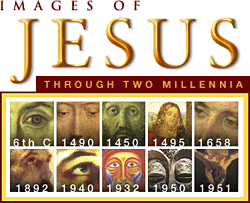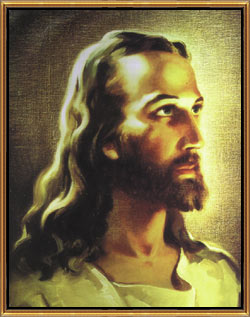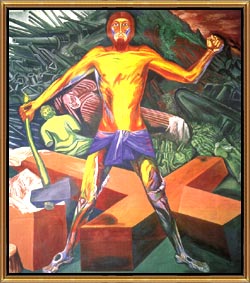By Stephen Cook

Did Jesus have a beard? The Bible doesn’t tell us, and, in fact, the word "beard" doesn’t appear in the New Testament. Although Jewish custom may have required men to be bearded, many of the earliest images of Jesus show him beardless.
How then did our image of Jesus develop? Fairly early in history, he was shown as a man on the verge of middle age, with brown to black hair and beard, and an appearance of sorrow and compassion. Beyond this, however, each age has produced its own variant of the Jesus image to meet its own needs, projections, and beliefs.
Christ Pantocrator

The image of "Christ Pantocrator," the "ruler of all," was developed in the Byzantine period. The Byzantine Empire replaced the ruling gods of Rome with a regal Jesus, an all-powerful imperial image, haloed, awesome, just, unchanging in majesty. That image continues to pervade Western consciousness.
Christ as Salvator Mundi

Christ as Salvator Mundi" comes from the Gothic tradition, when artists produced images that mirrored the real world and could be touched and understood in the natural sense. That tradition led to our love of sight and touch, and the acceptance of a Jesus of physical beauty and grace.
Resurrection

Piero della Francesca was among the earliest artists of the Renaissance, which revived the philosophical and artistic ideals of Greece and Rome. Artists produced human but lofty images of Jesus as vehicles for the profound concepts with which the church and the individual were wrestling -- and still wrestle.
The Last Supper

Some works of art freeze a moment for us, and that frozen image becomes that moment in history. Da Vinci's "Last Supper" has become totally accepted as representing Jesus’ last meal with his disciples. Even though it probably bears almost no resemblance to the real event, it has been the model for countless popular recreations.
Head of Christ

Rembrandt's profound insights into human character met the emotionalism of the Baroque period. The combination allowed his genius to flourish and produce the image of Jesus that is still accepted by many as the "real" Jesus, an agreed-upon image that is seen as both comforting and incontrovertible.
Friend of the Humble

Artists have tried to represent Jesus in what they perceived to be his natural surroundings. Such images may help us to understand the physical truth of the Incarnation and the Jesus who walked among us. This painting of the supper at Emmaus is important for this truth, as the resurrected Christ looked like an ordinary man.
Head of Christ

Warner Sallman produced a modern popular image of Jesus that became one of the most-reproduced paintings of all time, showing up in countless church parlors and classrooms and on devotional materials. It became the dominant image of Christ in the 20th century and the one people most often recall when asked what Jesus looked like.
The Epic of American Civilization: Modern Migration of the Spirit (Panel 21)

For Orozco and other modern Third World artists, Jesus becomes the liberator, or, more narrowly, the icon of liberation. The oppressed have, from Jesus' own time on, clung to him in hope of release from injustice and from dominance by the ruling class. Images such as these become icons of hope.
The Christ of St. John of the Cross

For many modern artists, images in the mind and the dream bear little connection to the real world, and these mental images are held to be our real life after all. Salvador Dali allowed his image of Jesus to become mystical and weightless, a concept still of great value in the modern spiritualist movement.
Processional Cross

In cultures that have no artistic connection to the West, but where Jesus becomes known and the need for an image arises, artists and artisans produce images that convey the spiritual qualities of Jesus in the visual language of their worlds -- as in this processional cross from Zaire -- and the image of Jesus is refreshed and expanded.



Tidak ada komentar:
Posting Komentar